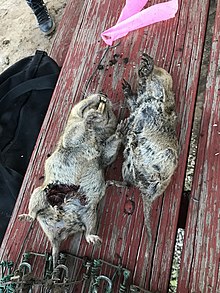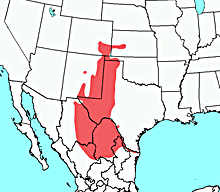Yellow-faced pocket gopher
| Yellow-faced pocket gopher | |
|---|---|

| |
| At Alpine, Texas, US | |
| Scientific classification | |
| Domain: | Eukaryota |
| Kingdom: | Animalia |
| Phylum: | Chordata |
| Class: | Mammalia |
| Order: | Rodentia |
| Family: | Geomyidae |
| Genus: | Cratogeomys |
| Species: | C. castanops
|
| Binomial name | |
| Cratogeomys castanops (Baird, 1852)
| |
| Subspecies | |
|
See text | |

| |
| Range of Cratogeomys castanops | |
| Synonyms | |
| |
The yellow-faced pocket gopher (Cratogeomys castanops) is a species of pocket gopher that is native to shortgrass prairies in the south-western United States and northern Mexico. It is the species that lives north of the Southern Coahuila Filter-Barrier (SCFB).[2] Among the different species, the yellow-faced pocket gopher has a small to medium-sized skull.[3] The fossil of this genus was recorded from the pre-Pleistocene Benson Beds of Arizona.[4]
The yellow-faced pocket gopher has a yellowish-brown coat, a short tail, and one deep groove down the anterior middle of each incisor.
Form and function
[edit]Adults of C. castanops in Texas begin to molt in August and continue through March. The new pelage was found to be thicker, but had no change in color [5] In Kansas, semiannual molts in adults have been reported: 1. Molt from winter to summer early in the spring and 2. Molt in autumn in September and October [6]
There is sexual dimorphism in the yellow-faced pocket gophers; the males are larger than the females. The males of all genera of pocket gophers continue to grow after attaining sexual maturity, but females grow little after reaching sexual maturity.[7]
Ontogeny and reproduction
[edit]The reproductive activity of yellow-faced pocket gophers start in November and increases to a peak in March and/or April [8] During mating and copulation, the males emits low guttural squeaks throughout exploratory activities, then the male bites the female when body contact is made.[5] When young animals are old enough to leave the nest, they travel about maternal burrows. Then, when the young are nearly full grown, they disperse from the parental burrow.[9]
Behavior
[edit]Researchers have seen a swimming ability in yellow-faced pocket gophers.[10] However, this genus of pocket gophers are less durable than other genera in water, perhaps because of the greater bulk (of its body) that inhibits its endurance.
Most of the foraging is done from the burrow system the yellow-faced pocket gophers create, pulling plants into the burrow by their roots.[9] The burrow system consists of tunnels dug by the gophers averaging 75.8m in length and 10 to 132 cm in depth.[11]
Ecology
[edit]Yellow-faced pocket gophers usually inhabit deep sandy or silty soils that are relatively free from rocks.[9] However, where Geomys (another genus of pocket gophers) is present, Cratogeomys is restricted to "denser, shallower, sometimes rocket soils."[12][13] Research in Kansas showed that tracts that had no gophers occupying it consisted largely of areas with fine-textured soils that are planted with crops. The crops (corn, wheat, and grain sorghum) were harvested and disked annually along with the roadside ditches adjacent to the cropland. It was concluded that pocket gophers are not able to inhabit these lands because land-use practices have destabilized the habitats, eliminating both refuge and dispersal corridors.[14]
Yellow-faced pocket gophers are preyed on by small carnivorous mammals and large hawks and owls.[7][15]
Subspecies
[edit]There are currently 18 identified subspecies[16] of Cratogeomys castanops:
- C. c. angusticeps
- C. c. bullatus
- C. c. castanops
- C. c. clarkii
- C. c. consitus
- C. c. dalquesti
- C. c. excelsus
- C. c. hirtus
- C. c. jucundus
- C. c. parviceps
- C. c. perexiguus
- C. c. perplanus
- C. c. pratensi
- C. c. sordidulus
- C. c. subsimus
- C. c. surculus
- C. c. tamaulipensis
- C. c. ustulatus
References
[edit]- ^ Cassola, F. (2017) [errata version of 2016 assessment]. "Cratogeomys castanops". IUCN Red List of Threatened Species. 2016: e.T16025A115131062. doi:10.2305/IUCN.UK.2016-3.RLTS.T16025A22216913.en. Retrieved 11 November 2022. Database entry includes a brief justification of why this species is of least concern
- ^ Hafner, David J.; Hafner, Mark S.; Hasty, Gerald L.; Spradling, Theresa A.; Demastes, James W. (2008). "Evolutionary Relationships of Pocket Gophers (Cratogeomys castanops Species Group) of the Mexican Altiplano". Journal of Mammalogy. 89: 190–208. doi:10.1644/07-MAMM-A-001.1.
- ^ Russell, R. J. , 1968b. Revision of pocket gophers of the genus Pappogeomys. Univ. Kansas Publ., Mus. Nat. Hist., 16:581-776
- ^ Russell, R. J., 1969. Intraspecific population structure of the species Pappogeomys castanops. Pp. 337-371, in Contributions in mammalogy (J. K. Jones, Jr., ed.). Misc. Publ. Mus. Nat. Hist., Univ. Kansas, 51:1-428
- ^ a b Ikenberry, R. D. 1964. Reproductive studies of the Mexican pocket gopher, Cratogeomys castanops perplanus. Unpubl. M.S. thesis, Texas Tech Univ., Lubbock, v + 47pp.
- ^ Birney, E. C., J.K. Jones, Jr., and D. M. Mortimer. 1971. The yellow-faced pocket gopher, Pappogeomys castanops, in Kansas. Trans. Kansas Acad. Sci., 73:368-375
- ^ a b Chase, J. D., W.E. Howard, and J. T. Rosenberry. 1982. Pocket gophers, Geomyidae. Pp. 239-255, in Wild mammals of North America: biology, management, and economics (J.A. Chapman and G.A. Feldhamer, eds.). Johns Hopkins Univ. Press, Baltimore, xiii + 1147 pp.
- ^ Smolen, M. J., J. J. Genoways, and R. J. Baker. 1980. demographic and reproductive parameters of the yellow-cheeked pocket gopher (Pappogeomys castanops). J. Mammal., 61:224-236
- ^ a b c Bailey, V. 1932. Mammals of New Mexico. N. Amer. Fauna, 53:1-412, 22 pls.
- ^ Hickman, G. C. 1977b. Swimming behavior in representative species of the three genera of North American geomyids. Southwestern Nat., 21:531-538.
- ^ Hickman, G. C. 1977a. Burrow system structure of Pappogeomys castanops (Geomyidae) in Lubbock County, Texas. Amer. Midland Nat., 97:50-58
- ^ Birney, E. C., J.K. Jones, Jr., and D. M. Mortimer. 1971. The yellow-faced pocket gopher, Pappogeomys castanops, in Kansas. Trans. Kansas Acad. Sci., 73:368-375
- ^ Findley, J. S. 1987. The natural history of New Mexican mammals. Univ. New Mexico Press, Albuquerque, xii + 164 ppl, 16 unnumbered pls.
- ^ Hoffman, Justin D.; Choate, Jerry R.; Channell, Rob (2007). "Effects of Land Use and Soil Texture on Distributions of Pocket Gophers in Kansas". The Southwestern Naturalist. 52 (2): 296–301. doi:10.1894/0038-4909(2007)52[296:EOLUAS]2.0.CO;2. ISSN 0038-4909.
- ^ Jones, J. K., Jr., D.M. Armstrong, and J. R. Choate. 1985. Guide to mammals of the plains states. Univ. Nebraska Press, Lincoln, xix + 371 pp.
- ^ Patton, J. L. (2005). "Family Geomyidae". In Wilson, D. E.; Reeder, D. M. (eds.). Mammal Species of the World: A Taxonomic and Geographic Reference (3rd ed.). Johns Hopkins University Press. p. 859. ISBN 978-0-8018-8221-0. OCLC 62265494.

